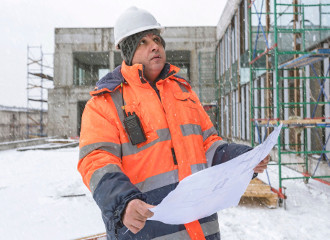Construction in Winter
Back to blogConstruction in Winter: An Overview
Winter is the bane of every site manager’s life. Snow and frozen ground hinders progress and the cold kills productivity, with most sites experiencing a drop-off of about 50%. The weather also introduces a whole host of extra hazards to an already dangerous environment. Should precautions not be taken, companies could find themselves landed with personal injury claims from slips, trips and exposure to cold.
So we’ve put together an overview of the main areas to be aware of.

Lighting
Lighting is crucial as the days get shorter. Poor lighting leaves hazards less visible and therefore more of a threat.
LED is the future. Runtime is generally 20 times greater than the halogen equivalent, with running costs only 9% of the cost of halogen. Admittedly, the upfront cost tends to be roughly double, but the savings in electricity and replacement bulbs soon offset this. Most importantly, you’ll be free of the hassle of bulbs blowing and having to be replaced.
Quick checklist: (from HSE guidelines)
- Lighting should be bright enough to see what you are doing and to notice hazards and colours
- Lights should not be located near to flammable materials (halogen lights generally specify minimum distance on a sticker)
- Lights should not cause glare or flicker
- There should not be big differences in lighting in two nearby areas
What is ‘enough’ light?
Generally, this can be judged by common sense – can you see enough to carry out the job safely? However, HSE have official guidelines on the matter:
- Movement of people, machines and vehicles in hazardous areas (outdoors work) – 20 lux minimum, 50 lux ideal
- Work requiring limited perception of detail (indoors work) – 50 lux minimum, 100 lux ideal
- Work requiring perception of detail (offices) – 100 lux minimum, 200 lux ideal
And how do I measure lux?
There are such things as luxmeters, but for a quick and easy fix, free smartphone apps are available (search for ‘luxmeter’ or ‘light meter’ and take your pick).
Heating
Industry guidance is that the temperature should be ‘reasonable’ – a highly subjective measurement! Generally 16°C is recommended for offices, and 13°C for physical work. However, HSE acknowledge that heating on a construction site is a challenge to say the least. A digital thermometer is worth having, especially if you are bricklaying.
Often, warm clothing is a better option than trying to heat an unfinished building. However, if you’re going to go for space heaters, you’ve got the choice of oil, gas or electric powered. Propane heaters can be particularly dangerous, and will be very expensive to run. Whatever the site conditions, providing a warm space for site workers to warm up and dry out during breaks is essential for welfare and morale.
For the office or cabin, heating is more manageable. Here you have the option of convector heaters or fan heaters. Fan heaters heat a room more quickly and spread the heat more evenly, but convector heaters are quieter and safer.
Dealing with snow/ice
The key tip here is to plan ahead. Spreading grit the evening before it is likely to freeze is far more likely to be effective and is definitely a more efficient use of grit.
For weather forecasting, there’s Met Office and Metcheck, but what a lot of farmers recommend is an app called WeatherPro (and they’re even more reliant on the weather than construction). The basic version is free and should be all you need.
If you’re going to be spreading a lot of grit, it makes sense to invest in a spreader. And distributing salt in grit binsaround site can make it easier to access than just one location. Keeping stock of snow shovelsmakes sense, as clearing snow with regular shovels isn’t much fun. When you’re clearing snow, make sure it is cleared downwards and away from buildings so that it doesn’t cause drainage issues when it melts.
If you’ve got machines on site, you’ll need stocks of screenwash and de-icer. A can of de-icer and scraper in each vehicle can save a lot of time on winter mornings.
If icy patches need cordoning off, ensure you have enough cones and barrier tape or personnel barriers to do so. HSE advise removing the barriers as soon as they are not needed, to avoid ‘barrier blindness’, where people stop paying attention to hazard warnings.
It’s also important to remember to grit and clear all emergency exits of snow and ice, not just the main entrances.
Clothing / PPE
Remember layers are most important here. A thermal base layer is hugely effective in keeping heat in (we recommend Thinsulate). Supplement that with warm and waterproof outer layer, such as a bomber jacket, and you should be sorted. If you’re likely to be in driving rain, a 2 piece waterproof suit can be a better option to stay bone dry. Pick decent quality waterproof safety boots, and you’ll benefit from anti-slip soles and warm linings (we’d go for the V12 Thunder). And don’t forget thermal socks!
If you are needing more grip than a boot can provide, overshoes such as Yaktrax or Icetrekker are ideal for snowy or icy conditions.
If the job involves heavy duty gloves, like rigger gloves, stockinette glove liners can help keep the warmth in without compromising protection. Likewise, helmet liners can be worn underneath safety helmets. This is a far better option than a beanie hat, as they are specifically designed to be worn with hard hats (if you’re lucky enough to have picked up one of our beanies, then make sure you are only wearing it in a non-hard-hat-area!).



